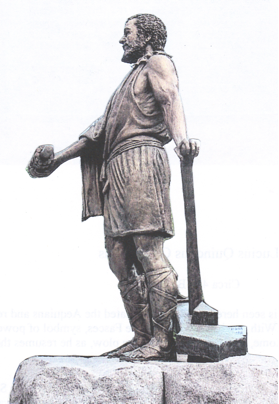The Society of the Cincinnati
The American Revolutionary War lasted 7 years and ended with British Lord Cornwallis’ surrendering to General George Washington at Yorktown, Virginia, in 1781. Independence had been won and the Continental Army and Navy were anxious to return home to their families. The French military forces who had come to the aid of the 13 Colonies were also eager to return to France. However, during the long military campaigns of the war there developed a strong friendship among the American and French Officers. To preserve this bond of friendship the Society of the Cincinnati was formed in May 1783. This new society was devoted to preserving the history of the Revolutionary War and to the fostering the bonds of friendship which had been formed among Washington’s officers and staff. George Washington who was called the “Cincinnatus of the West” was elected the society’s first President General, a position he held until his death in 1799.
This new society took its name from the Roman hero, Lucius Quanctius Cincinnatus, who by legend was a citizen-farmer called to lead his country to war in 458 B.C. and after victory against Rome’s enemies declined offers of power and position usually bestowed on war heroes. We are told that Cincinnatus left the army and returned to his farm. A large statue of Cincinnatus has been erected in the City of Cincinnati, Ohio. It shows the Roman hero returning the Fasces, a symbol of power as appointed dictator, with one hand and holding a plow with the other as he resumes the life of a citizen. Cincinnatus is a Latin word which means “curly hair.”

Lucius Quinctus Cincinnatus
The Society has from the beginning had three objects, referred to as the "Immutable Principles": "To preserve the rights so dearly won; to promote the continuing union of the states; and to assist members in need, their widows, and their orphans." Within 12 months of the founding, a constituent Society had been organized in each of the 13 states and in France. Of about 5,500 men originally eligible for membership, 2,150 had joined within a year. King Louis XVI ordained the French Society of the Cincinnati, which was organized on July 4, 1784 (Independence Day). Up to that time, the King of France had not allowed his officers to wear any foreign decorations; but he made an exception in favor of the badge of the Cincinnati. Today membership is limited to descendants of Revolutionary War officers and to individuals deemed worthy by the membership at large, i.e. high ranking military and political officials. Many of the past presidents of the United States have been elected to the Society.
Polish Brigadier General Koscuiszko was an original member of the Society along with Ohio’s first governor, Arthur St. Clair. Both men were on Washington’s staff at the British surrender at Yorktown. Other Society members included Alexander Hamilton; Marquis de La Fayette; Baron Von Steuben; Josiah Harmar; John Trumbull; David Ziegler (first Mayor of Cincinnati, Ohio); Ebenezer Denny (first Mayor of Pittsburgh, Pennsylvania).
The Civil War was a great trial to the Society as it was for all of the United States. Many Confederate and Union officers fighting each other were members of the Society. Nevertheless the Society recovered after the war and remains active into the twenty-first century. Today the Anderson House, at 2118 Massachusetts Avenue, NW, Washington, D.C., houses the Society's national headquarters and is opened free to the public.
(See www.hereditary.us/cin_anderson.htm for more information on the Society
